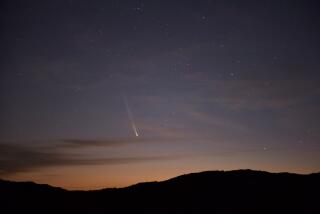Halley’s Comet Zips Off Into the Sunset
- Share via
Halley’s comet has all but dropped out of sight, and when it reappears in March only the early birds will be able to see it.
The comet has started its journey around the far side of the sun, and it is sinking closer to the horizon each night.
But for a few more days it may still be possible to catch a glimpse of it just after the sun goes down, although “it will be very difficult to see,” according to the International Halley Watch at the Jet Propulsion Laboratory in Pasadena.
Halley is 130 million miles away from Earth--72 million miles farther than it was on Nov. 27, when it made its closest approach on the inbound leg of its orbit. After passing around the sun the comet will again draw nearer to Earth, making its closest approach on April 11, when it will be 39 million miles away.
From this area, the comet will again be visible from March 6-20, about an hour before sunrise, according to Susan Wyckoff, an astronomer with Arizona State University who has spent the last few months studying the comet. However, the comet will be very low on the horizon, so only those observers who go to very dark areas with an unobstructed view of the horizon will be able to see it.
By then the comet should look quite different than it has up to now.
“The tail should come into view first, and it will stick straight up,” she said. Viewing time will be very short, however, because dawn will break just about the time that the head of the comet climbs above the horizon.
At that time, the eyes of the world’s astronomers will quite literally be focused on the comet.
“Approximately 100 (astronomical) sites on all continents, including Antarctica, will be set up” to photograph the comet, according to John C. Brandt, chief of astronomy at the Goddard Space Flight Center in Greenbelt, Md.
During that same period, five international spacecraft--two from Japan, two from the Soviet Union and one from Europe--will pass by the comet on scientific missions.
“It will be a veritable traffic jam,” Wyckoff said.
Although the view from the Northern Hemisphere is still expected to be disappointing to the public, scientists should have a ball.
“It may look wimpy in the sky right now. . . ,” Wyckoff said, “but scientists are not at all disappointed.”
She said some results are already turning up from the spacecraft now en route to the comet. One of the Japanese probes has determined that the comet brightens for awhile every 2.2 days, suggesting that something on its surface affects its luminosity at regular intervals. That, in turn, suggests that the comet is rotating once every 53 hours, she said.
Scientific interest in the comet is stimulated by the fact that it offers a rare opportunity to study the primordial nature of the solar system.
“Comets are unique,” Wyckoff said. “They are the only things in the solar system that have not changed in 4 1/2 billion years.”
More to Read
Sign up for Essential California
The most important California stories and recommendations in your inbox every morning.
You may occasionally receive promotional content from the Los Angeles Times.













